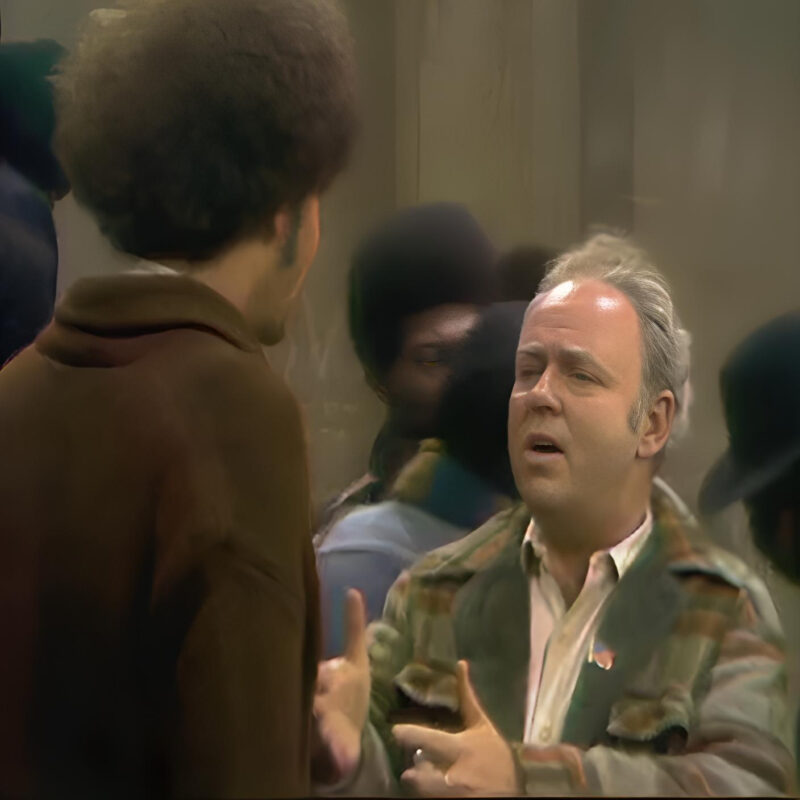
Before “All in the Family” debuted, there was a stark divide between the realities of life and what was depicted on TV.
In his autobiography “Even This I Get to Experience,” Norman Lear wrote, “Until ‘All in the Family’ came along, TV comedy was telling us there was no hunger in America, we had no racial discrimination, there was no unemployment or inflation, no war, no drugs, and the citizenry was happy with whomever happened to be in the White House.”
When Lear and Bud Yorkin pitched “All in the Family” to CBS, the network executives were looking for something different, but perhaps not as radically different as what Lear and Yorkin had in mind.
A week before the unpublicized sitcom debuted on January 12, 1971, Variety’s Les Brown summed up the first four months of the new season for the three networks. He noted that CBS had a firm hold on the “rural middle-American viewership” with its “rustic sitcoms” but had struggled to present shows with a social conscience. CBS aimed to “de-ruralize and get in step with the times”—to become relevant, Brown wrote.
When “AITF” premiered at 9:30 p.m. on a Tuesday, it followed a lineup of “The Beverly Hillbillies,” “Green Acres,” and “Hee Haw.”
The country was experiencing enormous unrest, leading some to predict a second Civil War. Here’s a glimpse of the real world that TV series were not depicting at the time:
1968:
- Martin Luther King Jr. and Robert Kennedy were assassinated.
- Police clubbed demonstrators at the Democratic National Convention in Chicago.
- U.S. troop involvement in Vietnam hit an all-time high of 536,100.
- Paris protests erupted.
- The U.S.S.R. invaded Czechoslovakia.
- Police officers in Mexico City killed dozens (possibly hundreds) of unarmed students.
- Thousands of Mexican American California students staged a walkout to protest substandard education and racism.
- Howard University students protested the school’s curriculum and administration.
1969:
- Four concertgoers were killed at Altamont.
- The Manson family murdered Sharon Tate and the LaBianca household.
- First reports of the My Lai massacre emerged.
- Native Americans occupied Alcatraz Island, asserting their right to unclaimed federal territories.
1970:
- National Guard shot and killed four students at Kent State.
- The U.S. invaded Cambodia.
- A crowd of 1,000 protesting the Kent State killings was attacked by construction workers in N.Y.’s “Hard Hat Riots.”
- Vice President Spiro Agnew described protesters as “kooks, misfits and bizarre extremists.”
While these events unfolded, the 1969-70 TV season’s Top 10 rated shows included “Rowan & Martin’s Laugh-In,” “Gunsmoke,” “Bonanza,” “Mayberry RFD,” “Family Affair,” “Here’s Lucy,” “Red Skelton Hour,” “Marcus Welby,” “Walt Disney’s Wonderful World of Color,” and “The Doris Day Show.” Except for NBC’s “Laugh-In,” which had topical barbs, the other shows offered escapism, with characters dealing with old-school values and storylines.
Network executives may have believed they wanted relevant shows, but the advertiser-driven system was hardly welcoming to anything “daring.”
A few examples illustrate this point:
- In March 1968, Petula Clark touched African American singer Harry Belafonte during a duet for her TV special. The head of advertising for sponsor Plymouth demanded the moment be cut. After a month of public furor, it was left intact.
- In February 1969, “Tonight Show” guest host Flip Wilson lifted a bottle of Vicks cough medicine. Previously, Black hosts were not allowed to touch the product being advertised. Variety explained that “Black men and women as product spokesmen are virtually non-existent.”
- The counter-culture variety show “The Smothers Brothers Comedy Hour,” featuring musical guests like The Doors, Jefferson Airplane, and Pete Seeger, and jokes about religion and the White House, was canceled on April 4, 1969. CBS’s Robert Wood said the brothers “were unwilling to accept the criteria of taste established by CBS.”
- When “The Mary Tyler Moore Show” debuted in September 1970, Mary Richards was originally supposed to be a divorcee, but it was changed to a woman recovering from a broken engagement because divorce was too controversial.
On July 22, 1970, after CBS had bought 13 episodes of “All in the Family,” Variety reported that CBS’s Wood said the network needed to “get in step with contemporary life.” He supported the show “against the judgment and advice of many of the CBS old pros who feel the show will give the web nothing but headaches.”
The set of the Bunkers’ living room, designed by Don Roberts, included a small but important detail: a TV set. While most Americans arranged their furniture around the television, very few sitcom families had this all-important piece of furniture. Additionally, “AITF” viewers heard the sound of a toilet flushing, groundbreaking for a series.
These details may seem insignificant, but they signaled to viewers that this family, while fictional, lived in the same world as they did. They were closer to reality than the families typically portrayed on TV.
This realism was why CBS executives were apprehensive, but it was also why audiences embraced the show.
